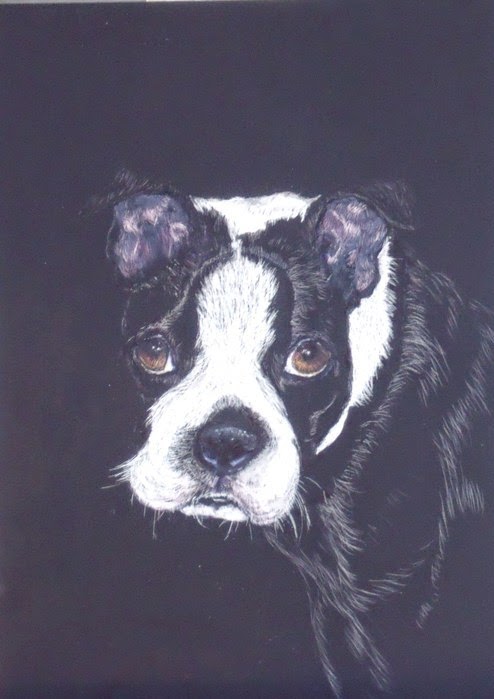Boston Terrier Scratchboard Update
Think this will pretty much complete the Boston Terrier scratchboard. Unsure of whether I need to do something on the viewer's left side to give more definition to the black area of the head. In a regular picture we'd have a color background to accentuate this. This is the 5x7 sized board which went a lot faster and I learned that it never really gets down to white, there are different shades of white. For the coloring this time I used watercolor pencils. Wetting the lead with the brush and then applied watercolor liquid with the brush. I also tried very hard not to mark up the background surface. If, after looking at it for a few days, I'm satisfied, I will apply a Krylon sealer which is supposed to take all marks and neutralize them. If sealed, they say you don't have to cover with glass but can display like an oil painting. Still haven't tried the real Ampersand inks yet, but not sure I can get the color range, and dilute them enough to get the hints of color that I wanted. I do want to get brave enough to attack the stripes on the 11"x14" zebra that I have drawn out and try out the white clayboard that you paint on first and then scratch off the paint instead of the India ink. One of those may be the next project, but do feel I have to do something else for a mini break and have a couple of things in mind - thinking more in my shoe series.
Still thinking about colors and studying on that as well, so here are some general tips on mixing:
Still thinking about colors and studying on that as well, so here are some general tips on mixing:
TIPS ON MIXING COLORS
1) Develop the habit of staring with the lightest color
(if light blue, add blue to white, for green start w/yellow and add blue)
2) when modifying color, question the type of change
that is actually needed. Ask if color is too light or dark, too warm
or cool, and/or too bright or dull?
3) As you mix new colors, start with warms and then
cool them as necessary as you are painting. It is easier to cool a
warm than to warm a cool. i.e. yellow-green can be cooled quickly
with a little blue
4) Use a flexible palette knife rather than a brush to
mix colors on your palette and sometimes to place colors on your
canvas. Brushes retain color traces that muddy colors.
5) Don't over mix colors on your palette. A lightly
mixed, almost marbleized effect is more interesting to the eyes and
keep your painting looking fresh
This isn't the end of these tips, more to come. Boy it's complicated!!!!
Thanks for stopping by and hope you are having a great weekend.




Comments
Love his eyes...!!!!! (I wouldn't touch it.!)
Caroline